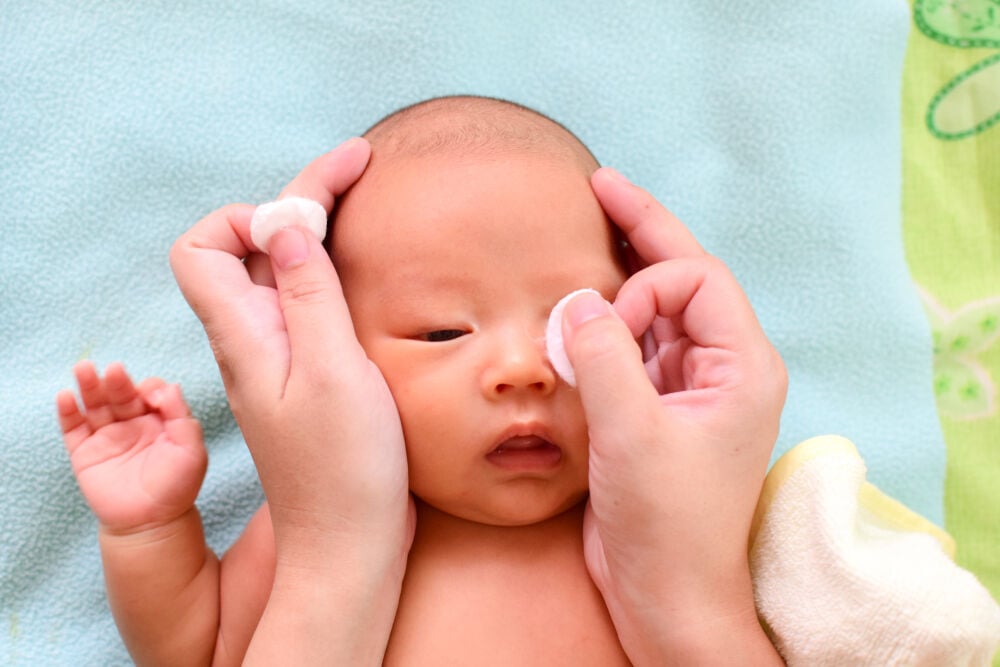-
Tracking cycle
-
Getting pregnant
-
Pregnancy
-
Help Center
-
Flo for Partners
-
Anonymous Mode
-
Flo app reviews
-
Flo Premium New
-
Secret Chats New
-
Symptom Checker New
-
Your cycle
-
Health 360°
-
Getting pregnant
-
Pregnancy
-
Being a mom
-
LGBTQ+
-
Quizzes
-
Ovulation calculator
-
hCG calculator
-
Pregnancy test calculator
-
Menstrual cycle calculator
-
Period calculator
-
Implantation calculator
-
Pregnancy weeks to months calculator
-
Pregnancy due date calculator
-
IVF and FET due date calculator
-
Due date calculator by ultrasound
-
Medical Affairs
-
Science & Research
-
Pass It On Project New
-
Privacy Portal
-
Press Center
-
Flo Accuracy
-
Careers
-
Contact Us
What Causes Watery Eyes In Babies? Treatment, Risks, and Prevention


Every piece of content at Flo Health adheres to the highest editorial standards for language, style, and medical accuracy. To learn what we do to deliver the best health and lifestyle insights to you, check out our content review principles.
Why do babies have teary eyes?
Excessive eye-watering in babies may occur due to various medical conditions, including allergies, infections, the common cold, and a blocked tear duct. This symptom is also known as epiphora, which means that the eyes are producing excess tears. These are some of the causes of watering eyes:
Allergy
Red, watery eyes may indicate that your child has allergic conjunctivitis. The irritants that can cause an allergic reaction in the eye include dust, smoke, and pollen. Apart from red, watery eyes, your baby may also experience an itching or burning sensation and puffy or swollen eyelids.
Watery eyes may also occur due to hay fever or allergic rhinitis. Other symptoms and signs of this condition include:
- Sneezing
- Itchy and/or runny nose
- Postnasal drip and nasal congestion
- Pain or pressure in the ear canal
Infection
Infections such as conjunctivitis may also cause your baby’s watery eyes. The cause of conjunctivitis (also called a pink eye) is usually a virus or, less commonly, bacteria. Some of the other symptoms of conjunctivitis include:
- Red, watery eyes
- Pus-like discharge from the eyes (in the case of bacterial conjunctivitis)
- Swelling of the eyes
You may pass an infection such as gonorrhea or Chlamydia to your newborn baby during childbirth, even if you don’t have any symptoms of the sexually transmitted infection. If your newborn baby shows any signs and symptoms of conjunctivitis, visit a physician immediately. He or she may examine the eyes of your baby for redness, dilatation of the blood vessels, and swelling.
Blocked tear duct
The blockage of a tear duct is a common cause of watery eyes in infants — more than 30 percent experience this condition. A tear duct drains the tears from the eyes into the nose by way of tiny openings present inside the eyelids. A blockage of the tear ducts prevents this movement, causing tears to accumulate in the eyes. Your baby may have a blocked tear duct at birth, as it isn’t fully open or the opening is very narrow. The condition gets better on its own in about 90 percent of babies by the time they reach one year old.
A blocked tear duct can also occur due to nasal polyps, a tumor or cyst, or trauma to your baby’s eye. Apart from constantly watery eyes, other symptoms of this condition include crusting in the eyelashes and eyelids and a pus-like discharge from the eyes.
Common cold
A common cold can also cause watering eyes. Babies are more prone to the common cold than adults, as they haven't established immunity and often touch their noses, mouths, and eyes, leading to the spread of germs. Your baby may also develop other symptoms of a cold, including sneezing, coughing, a decreased appetite or fever, and a runny or stuffy nose.
Risks of teary eyes
If your newborn baby gets teary-eyed, visit a pediatrician immediately. This may indicate a more serious illness, such as pink eye or conjunctivitis. Pink eye in newborns that occurs due to a bacterial infection needs treatment within one day of the appearance of symptoms.
You should also visit a doctor if you notice any of the following symptoms accompanying watery eyes in your baby:
- Inflammation
- A green or yellow discharge
- Redness
- Pain
- Sensitivity to bright light
- Changes in the structure of eyes or eyelid
- Itching in the eyes (your baby may rub them often)

Take a quiz
Find out what you can do with our Health Assistant
In many cases, the symptoms of watery eyes will get better on their own and your baby may not require much in the way of treatment. Sometimes, however, you may require a prescription medicine to clear the infection. Your baby may also need surgery to remove the blockage of a tear duct.
Home remedies to treat watery eyes in babies
If your baby's eyes are white and don’t appear irritated, or if a doctor advises you to, you may use home remedies. This can include massaging the blocked tear duct to help open it. This involves massaging the outer side of your baby's nose with your index finger. You may also apply a warm compress to the baby's eye to help clean it and provide some comfort.
Medical treatment
Medical treatment to manage watery eyes of your baby may be necessary if they have an infection or if the watering is persistent. In some cases, a blocked tear duct can get infected and require treatment with an antibiotic. Bacterial conjunctivitis also needs antibiotics. The doctor may advise rinsing your baby's eyes with isotonic solution to clear any buildup.
If the blocked tear duct doesn’t get better by itself, the doctor may advise treatment by surgical probing. In this procedure, the doctor inserts a small metal wire or probe through the tear duct of your baby into their nose to open the obstruction. The procedure needs either local or general anesthesia.
How to prevent watery eyes
You may prevent your baby from having watering eyes by taking the following steps:
- Maintain good hygiene: Keep your baby's hands and toys clean. Anyone suffering from a common cold shouldn’t come near the baby. If they do, they should wash their hands thoroughly before touching the baby.
- Check for blockage of tear ducts: Your newborn baby may be born with a blocked tear duct. If you notice that your baby's eyes water persistently, visit a doctor to rule out a blockage of a tear duct.
- Manage allergies: If you know that your baby suffers from allergies, make every effort to avoid the allergens that trigger them.
Watery eyes may be present in babies due to various medical conditions, including allergies, a blocked tear duct, a common cold, and infections. You need to visit a pediatrician if your newborn baby develops teary eyes, as it may be an indication of conjunctivitis or pink eye, which, if bacterial, should be treated within a day of its occurrence. Treatment for watery eyes depends on the cause and may include simple home remedies such as massaging the blocked tear duct or medical treatment like antibiotics to clear the infection.


Hey, I'm Anique
I started using Flo app to track my period and ovulation because we wanted to have a baby.


The Flo app helped me learn about my body and spot ovulation signs during our conception journey.


I vividly
remember the day
that we switched
Flo into
Pregnancy Mode — it was
such a special
moment.
Real stories, real results
Learn how the Flo app became an amazing cheerleader for us on our conception journey.




